(3751 products available)
























































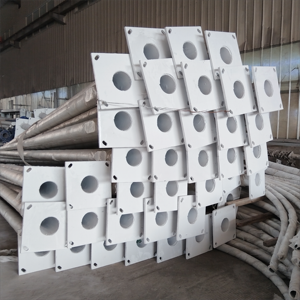
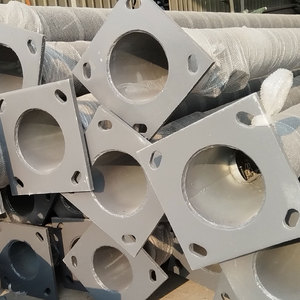
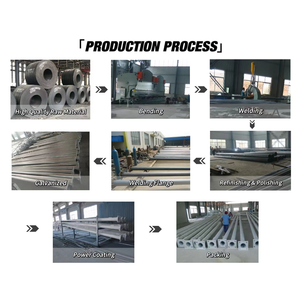
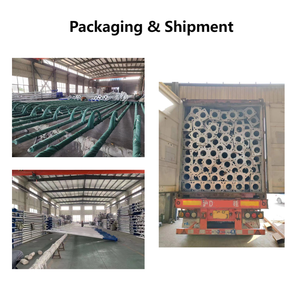

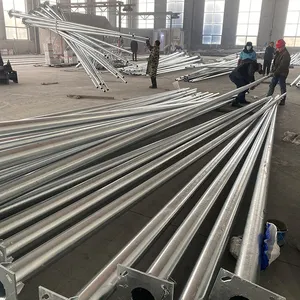


































































































































A conic lamp pole is a lighting pole that is shaped like a cone. It is narrow at the bottom and gradually widens toward the top. This design makes the pole look sleek and modern. It is popular for street lighting and other outdoor lighting areas. It can also be known as a conical pole or a conic light pole.
The conic light poles come in different sizes. Larger-sized lamp poles are used for outdoor lighting areas, while smaller poles are used for outdoor lighting in parks and gardens.
The conic lamp poles can also be made from different materials, like aluminum and fiberglass. They are lightweight materials, making it easy to transport the poles. They can also be made from steel and iron, which are more durable.
The conic lamp poles usually have a light fixture installed at the top. The light shines down to illuminate the area. Some conic lamp poles have multiple light fixtures.
There are various types and designs of conic lamp poles, including:
Conical lamp posts have several features and functions, including:
Design and Aesthetics
The conic shape is characterized by a tapered design that widens from the base to the tip. Its design gives an elegant and modern look, making it a popular choice for decorative and functional lighting. Due to its shape, it can blend into various environments, from urban areas to parks and gardens.
Stability and Strength
The conical form distributes wind and weather stress evenly throughout the pole. This feature allows for the dissipation of forces more efficiently, reducing the risk of damage during storms or high winds. Additionally, the shape and stability make it a stable lighting option for areas with adverse weather conditions.
Material
Conical lamp posts are manufactured using different materials, which can be selected depending on the intended use and environment. Common materials include aluminum, which is light and resistant to rust; steel, known for its strength; and fiberglass, which is a popular choice for decorative lamp posts due to its lightweight and rust-resistant features. The material used for manufacturing affects the pole's durability, maintenance needs, and aesthetic appearance.
Height
Conic lamp poles come in various heights that range from 3 to 12 feet. Their height increases depending on the intended use, location, and required illumination. Taller conical poles are used for lighting larger areas, such as sports fields and parking lots. Shorter poles are commonly used for lighting residential streets and gardens.
Lighting Fixtures
Lighting fixtures are installed at the top of the conic lamp post's pole. This space can accommodate different types of lighting, including LED, fluorescent, and halogen lights. Additionally, the lighting at the top provides illumination at various angles and intensities to meet different needs.
Base
The base of the conic lamp pole is crucial as it provides support and stability. There are several ways bases can be installed, such as bolting to a concrete foundation or embedding in concrete. Some lamp posts have decorative bases that enhance aesthetics, while others are simple and functional.
Maintenance
Conical lamp posts are manufactured with maintenance in mind. They are made of materials that are resistant to rust and corrosion. This helps reduce the frequency of maintenance required to keep the poles in good condition.
Lamp poles are designed for various applications. They come in different designs, materials, and sizes tailored to specific functional and aesthetic requirements. Here are the common usage scenarios:
Street Lighting
Conic lamp poles are commonly used in urban and rural street lighting systems. They're designed to provide illumination for roadways, sidewalks, and public spaces. Their height and stability ensure even light distribution, enhancing visibility and safety.
Parking Lot Lighting
The conic lamp poles are often installed in parking lots and garages. This ensures a well-lit environment for vehicles and pedestrians. This improves accessibility and minimizes the risk of accidents and criminal activities during the night.
Architectural Lighting
Lamp poles can be designed to support decorative and functional lighting fixtures. This enhances the beauty of buildings, monuments, and landscapes. They contribute to the visual appeal of urban spaces and architectural elements.
Park and Playground Lighting
These poles are installed in recreational areas such as parks, playgrounds, and sports facilities. They provide illumination for pedestrians, sports activities, and children’s play areas. This promotes the usage of these spaces during the night and ensures safety.
Commercial Lighting
Conic lamp poles are installed in commercial areas, including shopping malls, plazas, and resorts. They ensure proper lighting for walkways, building entrances, and outdoor dining areas. This enhances the ambience and accessibility of these spaces.
Highway Lighting
These poles are regularly placed along highways and major roads. They ensure consistent and stable illumination. This enhances visibility for vehicles and pedestrians. It also allows a smooth flow of traffic and minimizes the risk of accidents.
Utility Lighting
Some lamp poles are designed to support utility lighting for telecommunications. This includes electrical power lines and internet cables. Their elevated positioning and sturdy construction enable the reliable distribution of essential services.
Residential Lighting
Conic lamp poles are commonly used in residential areas. This includes driveways, gardens and pathways. Their aesthetic design and illumination enhance the overall environment and provide safety for the residents.
Event and Temporary Lighting
These poles can support lighting fixtures for outdoor events. This includes concerts, festivals, and exhibitions. Their mobility and stability enable the reliable distribution of light in temporary setups.
When choosing lighting poles for sale, business owners should consider several factors to ensure they stock products that meet their customers' needs. Here are some of them:
Consider the Material
Each lighting pole material comes with its advantages. The steel lamp post is popular among contractors because it offers durability and strength. On the other hand, aluminum is lightweight and resistant to rust. Customers looking for aesthetic appeal will prefer the fiberglass conic lamp pole. Business owners should get lamp posts made of different materials to cater to various customer needs.
Assess the Height and Size
The height and size of the conic lamp post will determine the light distribution area. Buyers looking for lighting poles for large areas will settle for taller sizes like 10 ft to 20 ft. Business owners should ensure their stock has various sizes to meet the different specifications of their customers.
Look at the Design and Aesthetic Appeal
Although functionality is crucial, the aesthetic appeal of the conic lamp pole design is equally important. Buyers looking for lighting solutions for public spaces pay attention to the design and appearance of the lamp post. Business owners should get conic poles with different designs to cater to the needs of customers looking for lamp posts to install in recreational areas or residential landscapes.
Examine the Light Source Compatibility
It's important to check the compatibility of the conic poles with different light sources. Lamp posts that are compatible with LED lighting are more popular because of their energy efficiency. Business owners should ensure their conic lamp poles are compatible with various lighting sources to meet different customer specifications.
Evaluate Installation and Maintenance Requirements
Business owners should stock conic lamp poles that are easy to install and maintain. They should look at the installation requirements and choose lighting poles that don't need extensive equipment or professional services. Also, they should consider the maintenance needs and choose the poles that require minimal maintenance efforts.
Consider the Customer's Budget
Conic lamp poles come with different prices depending on the material used, brand and size. Business owners should look at their customer's budgets and get poles at affordable prices without compromising quality. This will ensure they meet the needs of customers looking for both high-end and budget-friendly options.
Q1: What are the sizes of lamp posts?
A1: There are various sizes of lamp posts. For example, in the conic pole lighting, there are three sizes: 3.5 meters, 4 meters, and 5 meters. The size of 3.5 meters is used for lighting in gardens, pathways, and courtyards. The 4-meter size is used for parking lot lighting, residential areas, and pathways. Finally, the 5-meter size is used for higher lighting applications, such as public squares, roadways, and commercial properties.
Q2: What are the components of a lamp post?
A2: A lamp post has several parts, including the base, pole, light fixture, and top. The base is the part that will be installed on the ground. It has a plate or flange. The pole is the vertical part of the lamp post. It is the part that holds the light fixture. The top is the part that finishes the pole. It comes in different styles, such as decorative or pointed.
Q3: How long does it take to install a lamp post?
A3: A lamp post will take about one day to install. However, the installation time will depend on some factors, such as the type of pole, the complexity of the installation, and the site conditions. For example, a solar lamp post will be easier to install than a traditional lamp post. This is because a solar lamp post does not require wiring or trenching.
Q4: How is a lamp post maintained?
A4: Lamp posts are easy to maintain. They will only require periodic cleaning and inspection. This will ensure that they remain in good condition. The cleaning will remove dirt, debris, and any obstructions. The inspection will identify any potential issues.